| Her Biography |
 Maria Antonia Josepha Johanna was born in Vienna, Austria, on November 2, 1755. She was the youngest daughter of the Empress Maria Theresa of Austria and the Holy Roman Emperor Francis I.
The Archduchess grew up in the highly moral environment of Empress Maria Theresa's court. Her mother was a strong leader and was beloved by her people. She arranged Antonia's marriage to the Dauphin of France to cement an alliance between Austria and France after decades of hostilities and the Seven Years' War. After tedious and lengthy negotiations, King Louis XV requested the hand of the Archduchess for his grandson and heir, Louis Auguste. In consideration of the marriage, her name was changed to Marie Antoinette. The name was thought to be more appropriate for the Dauphine of France and later, the Queen of France.
At the age of 14, Marie Antoinette was married via proxy to the Dauphin of France on 19 April in the Church of the Augustine Friars in Vienna. Her brother Ferdinand stood in as the bridegroom. Soon after, she left her homeland and traveled to the French palace of Versailles. Her immaturity and lack of a proper education aided in her ignorance of her situation. She failed to comprehend that her future actions and associations would define her social and political standings of court in Versailles. Unequipped for the change of lifestyle and culture, she was young, foolish and trusting where etiquette was the rule. She had not been given by nature to diplomacy and reflection, and in the artificial and pleasure-loving atmosphere of Versailles, her personality found hardly any chance for development beyond her youthful aspirations.
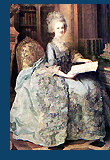 Upon meeting her new husband, she was bewildered by his lack of interest in her. The Dauphin was phlegmatic and withdrawn. In the beginning, it was thought that the Dauphin suffered from a physical defect, which caused him to be unable to consummate the marriage. The scrutiny of the situation became a political topic of open discussion within French society. Most of the blame was laid upon the young Dauphiness who had failed to be capable of attracting the interest of the Dauphin. In France, the union was altogether unpopular, and Marie Antoinette's actions only increased hostility toward her. For seven years her marriage remained unconsummated, a dangerous position for a young and ill equipped Dauphine. Upon meeting her new husband, she was bewildered by his lack of interest in her. The Dauphin was phlegmatic and withdrawn. In the beginning, it was thought that the Dauphin suffered from a physical defect, which caused him to be unable to consummate the marriage. The scrutiny of the situation became a political topic of open discussion within French society. Most of the blame was laid upon the young Dauphiness who had failed to be capable of attracting the interest of the Dauphin. In France, the union was altogether unpopular, and Marie Antoinette's actions only increased hostility toward her. For seven years her marriage remained unconsummated, a dangerous position for a young and ill equipped Dauphine.
Unhappy in her marriage, she escaped into a world of amusement. She feared nothing so much as boredom. With her two brothers-in-law as companions, she dedicated herself to the theatre, balls and card games which included gambling of high stakes. She surrounded herself with a dissolute clique, and threw herself into a life of pleasure. The court of Versailles was more rigid than the Austrian court, and she became increasingly rebellious. Her notorious reputation led to scandals of careless extravagance such as the Affair of the Diamond Necklace. There were also rumors concerning her relations with many officers of the guard and in particular with the Lieutenant General Count Hans Axel von Fersen, a Swedish diplomat.
 After the death of Louis XV in 1774, King Louis XVI and Marie Antoinette ascended to the French Throne. She was now the Queen of France at the age of nineteen. The Empress Maria Theresa back in Vienna knew her daughter well, and she was apprehensive that Marie Antoinette should have to bear the burden of a crown so early in life. In a series of letters full of advice and admonitions, the mother tried to guide her daughter along the right path, but Marie Antoinette was interested only in things that brought her gratification including fashion with its elaborate and absurd hairstyles and gambling. Her extravagant life style and the enormous sums spent on her pleasure that included Le Petit Trianon in the park of Versailles brought her increasing criticism. After the death of Louis XV in 1774, King Louis XVI and Marie Antoinette ascended to the French Throne. She was now the Queen of France at the age of nineteen. The Empress Maria Theresa back in Vienna knew her daughter well, and she was apprehensive that Marie Antoinette should have to bear the burden of a crown so early in life. In a series of letters full of advice and admonitions, the mother tried to guide her daughter along the right path, but Marie Antoinette was interested only in things that brought her gratification including fashion with its elaborate and absurd hairstyles and gambling. Her extravagant life style and the enormous sums spent on her pleasure that included Le Petit Trianon in the park of Versailles brought her increasing criticism.
On August 15, 1774, Louis XVI gave her free rein to renovate Le Petit Trianon as she wished. She concentrated mainly on horticulture, redesigning in the English mode the garden, previously an arboretum of introduced species. Though the small castle was built during Louis XV's reign, the Petit Trianon became associated with Marie Antoinette's perceived extravagance. Rumors circulated that she plastered the walls with gold and diamonds. In 1783, she ordered the creation of the Petit Hameau de la Reine, a rustic but in essence ersatz farm meant to evoke a peasant village in Normandy. This was a place she could escape to from the mounting horror of the real world. She reigned supreme in this small area, and even the King only went there at her invitation.
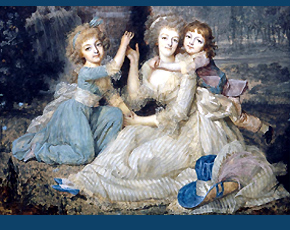
After the birth of Maria Theresa Charlotte (better known as "Madame Royale", December 19, 1778) and the death of Maria Theresa (her mother, November 29, 1780), she settled down to married life and become a devoted wife and mother. However, the damage was already done. Many French people hated the Queen for her Austrian blood and her formerly frivolous ways which they believe continued on. She was reviled in pornographic songs, pictures and pamphlets. There was even an autobiography published that claimed the Queen had authored in which she supposedly confessed her sins, calling herself a prostitute. Marie Antoinette was nicknamed "Madame Deficit" and was blamed for the country's financial problems. As a woman and foreigner, she made a convenient scapegoat for the nation's problems, and it seemed that no slander against her was too outrageous to be widely believed.
As she matured, she became less extravagant. She tried to change her image by wearing simple gowns and posing for portraits with her children, but her efforts had little effect on the unforgiving public. She had given France an heir and three children. For the remainder of her years, her children would be her primary focus. Her second child and first Dauphin son, Louis Joseph (October 22, 1781 – June 4, 1789) was weak and sickly for the majority of his life and died at the age of eight. Her third child and second Dauphin son, Louis Charles (March 27, 1785 – June 8, 1795), would live only a few years after her own death. Her fourth child, Sophie Beatrix (July 9, 1786 – June 19, 1787), died a month before her first birthday. However, her oldest daughter was the sole surviving member of her family that would go on to be to be the Duchess of Angouleme.
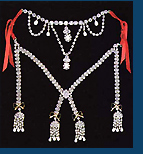 The greatest damage to her reputation was created by the scandal of the Diamond Necklace Affair. It is indicative of the loss of respect and popularity that she was to undergo. The ambitious Cardinal de Rohan fell into the clutches of a confidence trickster called Madame Jeanne de la Motte. Having lost favor years before, he was desperately seeking a means of regaining the The greatest damage to her reputation was created by the scandal of the Diamond Necklace Affair. It is indicative of the loss of respect and popularity that she was to undergo. The ambitious Cardinal de Rohan fell into the clutches of a confidence trickster called Madame Jeanne de la Motte. Having lost favor years before, he was desperately seeking a means of regaining the
|
| |
|
|
good graces of the Queen and the return of her family’s lands. Madame de la Motte convinced the Cardinal that the Queen wanted him to purchase for her a fabulous necklace made of 647 diamonds that was previous assembled for Louis XV to give as a gift to his mistress, Madame Du Berry. The Cardinal proceeded to acquire the necklace believing that he was acting on behalf of his Queen. Madame de la Motte took possession of the diamonds as the "so-called liaison" between the Cardinal and the Queen. She had her husband disassemble the necklace and smuggle the diamonds through out Europe to be sold.
When the expected payment from the Queen failed to materialize, the jewelers took their claim directly to the monarchy. The Queen was horrified in hearing of their calamity and did perceive that it was a plot to further discredit her. She demanded that the Cardinal de Rohan and the others responsible made to stand trial. The final outcome wasn’t what the monarchy had hoped. Madame Jeanne de la Motte was convicted and the Cardinal was acquitted by the Parliament. The consensus of the people believed that the extravagant and unpopular Queen must have been behind the matter. The Cardinal’s acquittal was openly celebrated as a victory over the "Austrian woman".
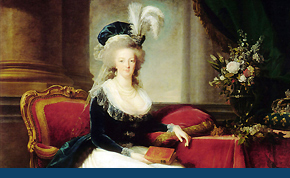
In foreign affairs, she did not intervene as frequently as has been asserted. Her interventions in politics were usually in order to obtain positions and subsidies for her friends. It is true that she usually opposed the efforts of reforming ministers and became involved in court intrigues against them. In the summer of 1788, when Louis XVI yielded to pressure of his ministers and convoked the Estates General to deal with the fiscal tax crisis, Marie Antoinette requested that the Third Estate have as many representatives as the First and Second combined. After the meeting of the Estates General on May 22, 1789 and such events as the taking of the Bastille, she supported the conservative court faction most insistent upon maintaining the Old Regime of the French Monarchy.
During the outbreak of the French Revolution and the raiding of the Bastille, the people demanded the royal family be moved to Paris and were placed under the watchful eye of the National Guard in the Tuileries Palace. They remained captive there for more than two and a half years. In 1791, Axel von Fersen, Marie Antoinette's rumored lover, arranged for the entire family's escape. His initial plan called for Louis and Marie Antoinette to leave Paris in a small, fast coach; and their children would travel separately to avoid suspicion. Louis insisted that the entire family travel together.
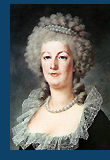 A new coach was built specifically for the journey; however, the higher consideration was made for comfort, not speed, which was a major flaw in the plan. It was a decision that sealed their fate. Their trip was impeded by slow travel progression, needless stops for the comfort of their children, and bestowing courtesy upon loyal subjects who recognized them. The end result was clear, they were recognized by parties who did not sympathized with their plight, arrested in the Varennes, and were escorted back to Paris, no longer the King and Queen of France. A new coach was built specifically for the journey; however, the higher consideration was made for comfort, not speed, which was a major flaw in the plan. It was a decision that sealed their fate. Their trip was impeded by slow travel progression, needless stops for the comfort of their children, and bestowing courtesy upon loyal subjects who recognized them. The end result was clear, they were recognized by parties who did not sympathized with their plight, arrested in the Varennes, and were escorted back to Paris, no longer the King and Queen of France.
In 1792, they were moved to the Temple of Paris, which was known also as the Temple Prison. It fell upon Marie Antoinette to negotiate with revolutionaries on the royal family's behalf because Louis was apathetic. Secretly, she urged Austria to intercede in France. When France went to war with Austria, the couple was charged with treason. The royal family was treated fairly well and was permitted to live together. In December of that year, Louis's trial began. He was found guilty of high treason and crimes against the state and sentenced to death. He went bravely to the guillotine on January 21, 1793.
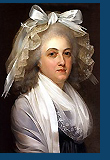 After Louis's death, his brother (the future Louis XVIII), who had escaped from France years earlier, proclaimed Marie Antoinette's son Louis Charles to be the new King of France. For several months after their father's death, Louis Charles and his sister, Maria Therese Charlotte, remained in prison with their mother. The children were often sick, and the Queen cared for them as best she could. Spitefully, their jailors decided to separate young Louis Charles from her. A few weeks later, she was separated from her daughter as well. The former Queen was awakened in the middle of the night and taken to the Conciergerie Prison. Louis Charles and Maria Theresa Charlotte remained in the Temple Prison and they never saw their mother again. After Louis's death, his brother (the future Louis XVIII), who had escaped from France years earlier, proclaimed Marie Antoinette's son Louis Charles to be the new King of France. For several months after their father's death, Louis Charles and his sister, Maria Therese Charlotte, remained in prison with their mother. The children were often sick, and the Queen cared for them as best she could. Spitefully, their jailors decided to separate young Louis Charles from her. A few weeks later, she was separated from her daughter as well. The former Queen was awakened in the middle of the night and taken to the Conciergerie Prison. Louis Charles and Maria Theresa Charlotte remained in the Temple Prison and they never saw their mother again.
Marie Antoinette was now labeled the "Widow Capet" and was accused of orchestrating orgies in Versailles, sending millions of livres of treasury money to Austria, plotting to kill the Duc d'Orléans, incest with her son, declaring her son to be the new king of France and orchestrating the massacre of the Swiss Guards in 1792. Like her husband, she was convicted of treason and sentenced to the guillotine.
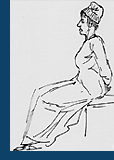 On October 16, 1793 at 10:00 am, she was taken through the streets of Paris in an open cart. She was dressed in a simple white dress. The trip from the Conciergerie to the place that is now known as the Place de la Concord took two hours and fifteen minutes. She maintained her dignity to the end. As she arrived on the scaffolding, she accidentally stepped on the executioner's foot. Her last words were, "Monsieur, I ask your pardon. I did not do it on purpose." On October 16, 1793 at 10:00 am, she was taken through the streets of Paris in an open cart. She was dressed in a simple white dress. The trip from the Conciergerie to the place that is now known as the Place de la Concord took two hours and fifteen minutes. She maintained her dignity to the end. As she arrived on the scaffolding, she accidentally stepped on the executioner's foot. Her last words were, "Monsieur, I ask your pardon. I did not do it on purpose."
She died two and a half weeks before her thirty-eighth birthday and was buried in an unmarked grave in the former La Madeleine cemetery (closed in 1794). Both her body and that of Louis XVI were exhumed on January 18, 1815, during the Bourbon Restoration, when the Comte de Provence had become King Louis XVIII. Proper Christian burial of the royal remains took place three days later, on January 21, in the necropolis of French Kings at St. Denis Basilica.
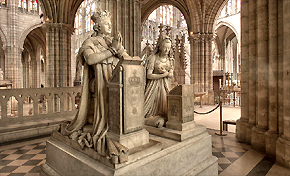
|
| |































|
| |
| |
| |
|

 Maria Antonia Josepha Johanna was born in Vienna, Austria, on November 2, 1755. She was the youngest daughter of the Empress Maria Theresa of Austria and the Holy Roman Emperor Francis I.
Maria Antonia Josepha Johanna was born in Vienna, Austria, on November 2, 1755. She was the youngest daughter of the Empress Maria Theresa of Austria and the Holy Roman Emperor Francis I.
 Upon meeting her new husband, she was bewildered by his lack of interest in her. The Dauphin was phlegmatic and withdrawn. In the beginning, it was thought that the Dauphin suffered from a physical defect, which caused him to be unable to consummate the marriage. The scrutiny of the situation became a political topic of open discussion within French society. Most of the blame was laid upon the young Dauphiness who had failed to be capable of attracting the interest of the Dauphin. In France, the union was altogether unpopular, and Marie Antoinette's actions only increased hostility toward her. For seven years her marriage remained unconsummated, a dangerous position for a young and ill equipped Dauphine.
Upon meeting her new husband, she was bewildered by his lack of interest in her. The Dauphin was phlegmatic and withdrawn. In the beginning, it was thought that the Dauphin suffered from a physical defect, which caused him to be unable to consummate the marriage. The scrutiny of the situation became a political topic of open discussion within French society. Most of the blame was laid upon the young Dauphiness who had failed to be capable of attracting the interest of the Dauphin. In France, the union was altogether unpopular, and Marie Antoinette's actions only increased hostility toward her. For seven years her marriage remained unconsummated, a dangerous position for a young and ill equipped Dauphine. After the death of Louis XV in 1774, King Louis XVI and Marie Antoinette ascended to the French Throne. She was now the Queen of France at the age of nineteen. The Empress Maria Theresa back in Vienna knew her daughter well, and she was apprehensive that Marie Antoinette should have to bear the burden of a crown so early in life. In a series of letters full of advice and admonitions, the mother tried to guide her daughter along the right path, but Marie Antoinette was interested only in things that brought her gratification including fashion with its elaborate and absurd hairstyles and gambling. Her extravagant life style and the enormous sums spent on her pleasure that included Le Petit Trianon in the park of Versailles brought her increasing criticism.
After the death of Louis XV in 1774, King Louis XVI and Marie Antoinette ascended to the French Throne. She was now the Queen of France at the age of nineteen. The Empress Maria Theresa back in Vienna knew her daughter well, and she was apprehensive that Marie Antoinette should have to bear the burden of a crown so early in life. In a series of letters full of advice and admonitions, the mother tried to guide her daughter along the right path, but Marie Antoinette was interested only in things that brought her gratification including fashion with its elaborate and absurd hairstyles and gambling. Her extravagant life style and the enormous sums spent on her pleasure that included Le Petit Trianon in the park of Versailles brought her increasing criticism.
 The greatest damage to her reputation was created by the scandal of the Diamond Necklace Affair. It is indicative of the loss of respect and popularity that she was to undergo. The ambitious Cardinal de Rohan fell into the clutches of a confidence trickster called Madame Jeanne de la Motte. Having lost favor years before, he was desperately seeking a means of regaining the
The greatest damage to her reputation was created by the scandal of the Diamond Necklace Affair. It is indicative of the loss of respect and popularity that she was to undergo. The ambitious Cardinal de Rohan fell into the clutches of a confidence trickster called Madame Jeanne de la Motte. Having lost favor years before, he was desperately seeking a means of regaining the 
 A new coach was built specifically for the journey; however, the higher consideration was made for comfort, not speed, which was a major flaw in the plan. It was a decision that sealed their fate. Their trip was impeded by slow travel progression, needless stops for the comfort of their children, and bestowing courtesy upon loyal subjects who recognized them. The end result was clear, they were recognized by parties who did not sympathized with their plight, arrested in the Varennes, and were escorted back to Paris, no longer the King and Queen of France.
A new coach was built specifically for the journey; however, the higher consideration was made for comfort, not speed, which was a major flaw in the plan. It was a decision that sealed their fate. Their trip was impeded by slow travel progression, needless stops for the comfort of their children, and bestowing courtesy upon loyal subjects who recognized them. The end result was clear, they were recognized by parties who did not sympathized with their plight, arrested in the Varennes, and were escorted back to Paris, no longer the King and Queen of France.  After Louis's death, his brother (the future Louis XVIII), who had escaped from France years earlier, proclaimed Marie Antoinette's son Louis Charles to be the new King of France. For several months after their father's death, Louis Charles and his sister, Maria Therese Charlotte, remained in prison with their mother. The children were often sick, and the Queen cared for them as best she could. Spitefully, their jailors decided to separate young Louis Charles from her. A few weeks later, she was separated from her daughter as well. The former Queen was awakened in the middle of the night and taken to the Conciergerie Prison. Louis Charles and Maria Theresa Charlotte remained in the Temple Prison and they never saw their mother again.
After Louis's death, his brother (the future Louis XVIII), who had escaped from France years earlier, proclaimed Marie Antoinette's son Louis Charles to be the new King of France. For several months after their father's death, Louis Charles and his sister, Maria Therese Charlotte, remained in prison with their mother. The children were often sick, and the Queen cared for them as best she could. Spitefully, their jailors decided to separate young Louis Charles from her. A few weeks later, she was separated from her daughter as well. The former Queen was awakened in the middle of the night and taken to the Conciergerie Prison. Louis Charles and Maria Theresa Charlotte remained in the Temple Prison and they never saw their mother again. On October 16, 1793 at 10:00 am, she was taken through the streets of Paris in an open cart. She was dressed in a simple white dress. The trip from the Conciergerie to the place that is now known as the Place de la Concord took two hours and fifteen minutes. She maintained her dignity to the end. As she arrived on the scaffolding, she accidentally stepped on the executioner's foot. Her last words were, "Monsieur, I ask your pardon. I did not do it on purpose."
On October 16, 1793 at 10:00 am, she was taken through the streets of Paris in an open cart. She was dressed in a simple white dress. The trip from the Conciergerie to the place that is now known as the Place de la Concord took two hours and fifteen minutes. She maintained her dignity to the end. As she arrived on the scaffolding, she accidentally stepped on the executioner's foot. Her last words were, "Monsieur, I ask your pardon. I did not do it on purpose."